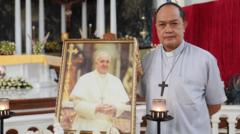The conclave has begun with 133 cardinals pledging to adhere to the traditions established for papal elections, ensuring a commitment to the church's guiding principles under the legacy of St. Peter.
Cardinals Initiate Papal Conclave with Oath of Secrecy

Cardinals Initiate Papal Conclave with Oath of Secrecy
Cardinals at the Vatican take an oath to uphold the rules governing the conclave as they begin the process of selecting the next pope.
Inside the historic Sistine Chapel, the 133 cardinals gathered to commence the conclave by taking an oath that binds them to the processes laid out by Pope John Paul II in the document from 1996. Led by the most senior cardinal, they recited an oath in Latin, committing themselves to faithfully fulfill the responsibilities of the new papacy in accordance with the rich traditions of the Catholic Church.
The oath entails promises to defend the spiritual and temporal rights of the Holy See, while also ensuring the confidentiality of the conclave proceedings. This commitment to secrecy is intended to preserve the integrity of the voting process, with all notes and ballots incinerated after each voting session to maintain privacy over deliberations. Such secrecy has historically been partially breached, with insights from Vatican insiders often leaking post-election, including in-depth accounts like the “secret diaries” that recounted key moments from past conclaves.
Each cardinal individually reaffirmed the oath, placing a hand on the Bible while declaring their intention to uphold the promise, invoking divine assistance in their commitment. Once all have taken the oath, Diego Ravelli, who oversees papal liturgical ceremonies, will issue the command “extra omnes,” signifying that all outside the voting populace must exit the chapel, with only a select few remaining. This process initiates what will be a highly secretive yet crucial decision-making period for the future of the Catholic Church.
Elisabetta Povoledo, a seasoned journalist based in Rome, continues to report on the complexities of Italian culture, with particular emphasis on the Vatican and its influential role.






















